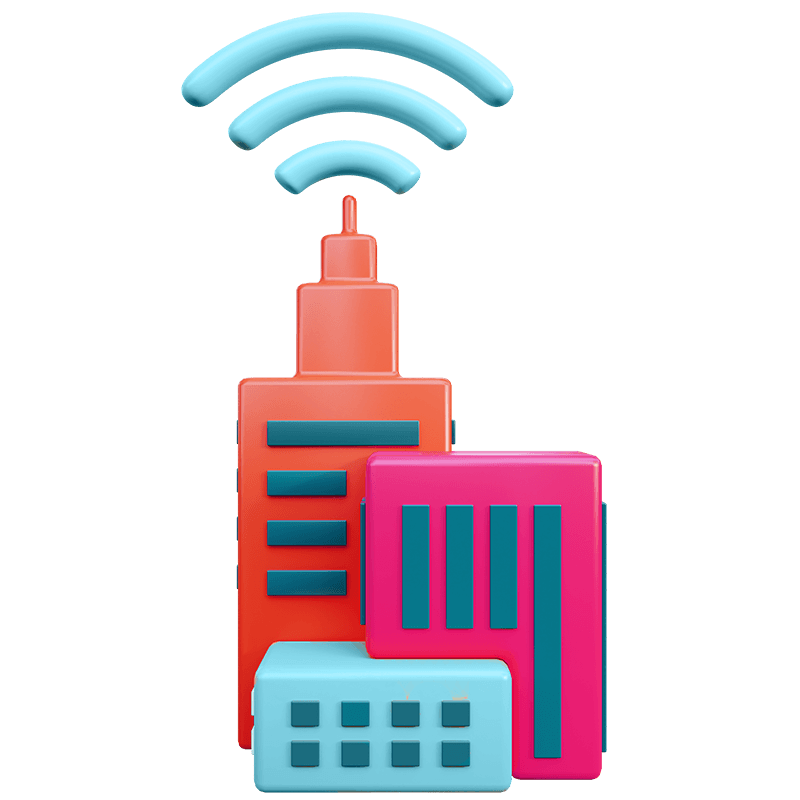

IoT (Internet of Things) is a network of connected devices, such as sensors, actuators and mobile devices, that collect and share data over the internet and that these devices are used to monitor and control systems, automating tasks and improving efficiency. IoT has many applications in sectors such as agriculture, industry, transport and healthcare, among many others.
In Portugal, the main frequency spectrums used for IoT include:
Sub-1 GHz: These frequency spectrums include bands such as 868 MHz and 915 MHz, which are used for long-range, low-power communication. They are commonly used in sensor monitoring and industrial automation applications.
2.4 GHz: This frequency spectrum includes the 2.4 GHz ISM (Industrial, Scientific and Medical) band, which is used by many wireless devices such as Wi-Fi and Bluetooth. It is suitable for short-range, high-speed communications.
5 GHz: This band is used for short-range communications, such as Wi-Fi, and is suitable for high data rate applications.
4G LTE: 4G LTE (Long-Term Evolution) technology is used to provide high-speed data connectivity for mobile devices and IoT.
5G: This technology is the latest available, and is designed to support a variety of IoT applications, including low latency, high speed and high capacity communications.
In addition, in Portugal, there is also dedicated spectrum for IoT, such as LoRaWAN (Long Range Wide Area Network) spectrum that is used for long range and low power consumption communications.
Until 7 February, the National Communications Authority (ANACOM), in the scope of the action “Plan and make spectrum available for new applications and services”, included in its multi-annual plan of activities, intends to ask the market once again about the current interest in the 700 MHz frequency band – the “700 MHz” band, which is the most widely used frequency band in the European Union. duplex gap guard bands – which remain available (694-703 MHz, 733-758 MHz and 788-791 MHz), their conditions of access and use, and the applicable timing for making them available.
This document made available for consultation presents various scenarios, and stakeholders are invited to share their views on the advantages and disadvantages of each. In addition, participants are asked to make additional suggestions. The need to reserve spectrum for specific applications and which applications should be priorities is also being assessed.

M2M/IoT radio enables the creation of a flexible network of devices that communicate with each other using network platforms in a cloud architecture, creating intelligent environments for users, and allowing them to control devices and applications remotely in an easy and convenient way.
The IoT market covers a variety of sectors, each with a different volume of applications available. Some of the sectors include: smart buildings, remote controlled energy management, alarms, meters, monitoring and control in industry, traffic management (traffic lights, traffic, parking), people tracking, property security, medical applications (patient monitoring, ambulances), automotive applications, insurance and agriculture.
This is important because the adoption of a particular application may prevent the adoption of other applications when they coincide in the use of the same spectrum.
According to the document: “The 700 MHz frequency band (duplex gap and guard bands), the subject of this consultation, has the advantage of providing greater coverage of remote rural areas and environments deep indoor allowing the massification of these applications, being one of the most harmonised bands globally and allowing the exclusive allocation of 2×3 MHz for M2M/IoT.” Other EU countries are already leading the way in this process.
Following the information contained in the document whose link we shared above, and in order to assist ANACOM’s analysis and decision process in this regard, anyone who wishes and considers having something to say on the matter can answer questions on the possible scenarios presented, such as, for example, the importance of providing a certain spectrum for which type of application(s) and when is it expected that there will be market demand.
E-mail for submitting contributions (by 7 February): p700duplexgap@anacom.pt.
See More: https://www.anacom.pt/render.jsp?contentId=1735819

WiseBuilding® is technically capable of supporting any interconnection and system monitoring project that involves IoT. Contact us.
WISEFRAMEWORK is a BACnet B-AWS certified software solution for state-of-the-art integration, control, management and visualisation in building automation systems. Designed to redefine the way buildings are operated through an open platform and seamless harmonisation between building-generated data by supporting multiple protocols including BACnet, Modbus, KNX, OPC-UA and MQTT. Through the use of Haystack technology, the software also empowers the building for the future at the forefront in the integration of the various technical systems.


